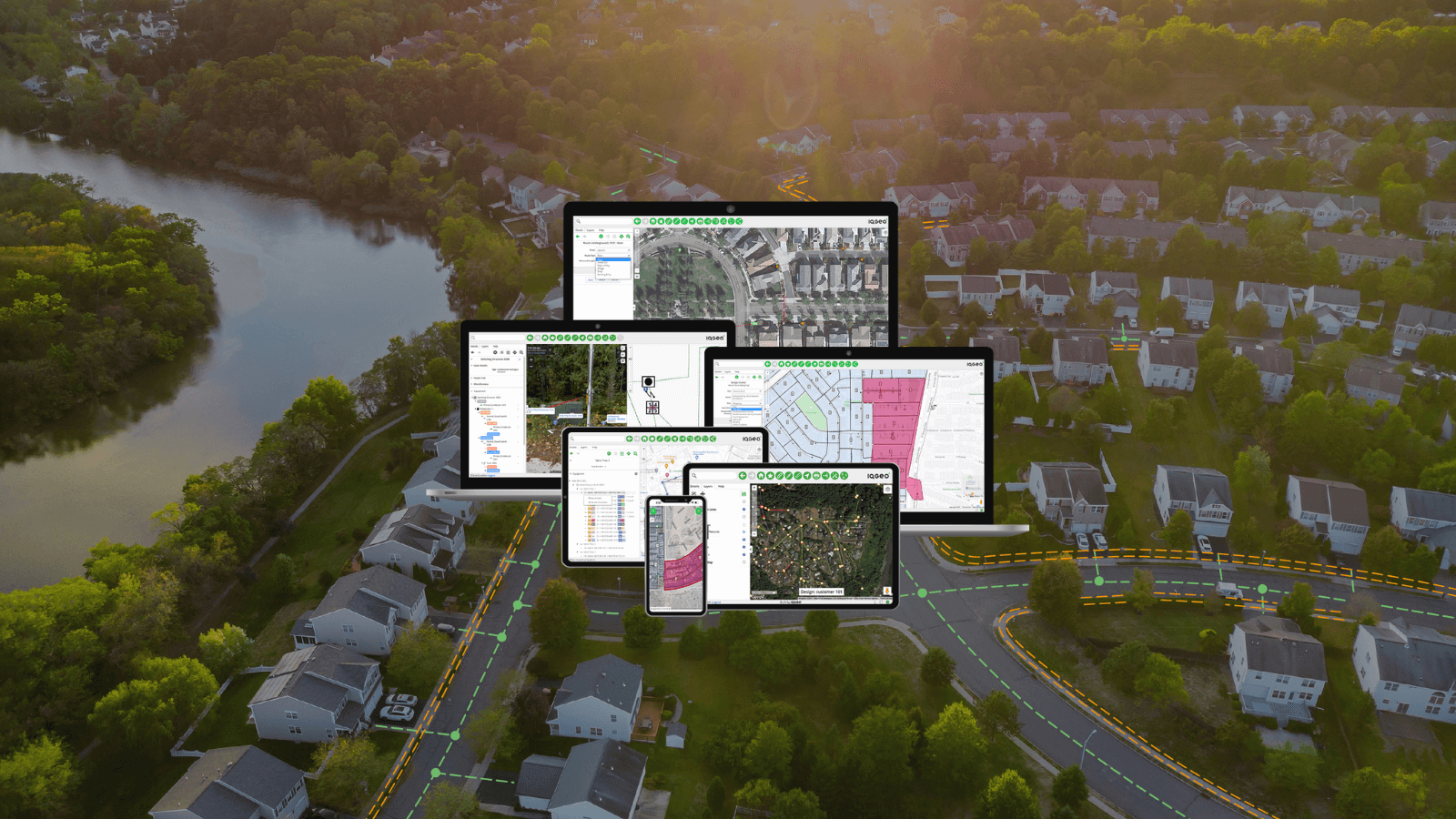The changing role of GIS in managing constantly evolving telecom networks and utility grids.
Geographic Information Systems (GIS) do many things incredibly well. However, telecom and utility companies have fallen into the trap of trying to solve too many problems with traditional GIS (e.g. Esri, Hexagon, GE Smallworld, 3-GIS, Schneider), taking these solutions outside of their core architecture into areas where they struggle to perform. When all you have is a traditional GIS hammer, every application and use case starts to look like a nail.
Fortunately, there is a new alternative pioneered by IQGeo for these organizations: Network Model Management. This new approach was created specifically for IT and engineering professionals to manage their constantly evolving fiber network and electric grid architectures. However, this doesn’t mean you need to abandon your GIS. By pairing Network Model Management solutions with a traditional GIS, utilities and telecom companies have the best of both worlds.
The growing GIS network functionality chasm
Traditional GIS solutions were initially designed for land-based mapping and analytics and have always struggled to model complex linear networks such as fiber optics and electric grids. Even when you try to bolt on additional modules to manage linear features, the land-based architecture DNA limits functionality and sets an unacceptable performance ceiling. Until recently, telecom and utility companies could survive with a tool not designed specifically for sophisticated networks, but the more complex market requirements and drastic speed of change have now overtaken traditional GIS capabilities – even with third-party industry modules on top of their GIS. For broadband and electricity operators to deliver the networks of the future, they need an entire toolbox of capabilities designed from the ground up for the next-generation architecture of their networks.
Network Model Management key requirements
IQGeo’s Network Model Management solutions provide four essential capabilities over a traditional GIS approach that uses third-party industry modules.
1. Performance and scalability
One of the consistent failures of applying traditional GIS to sophisticated network management is a lack of performance. Fiber networks now involve interconnected routes with thousands of fibers enabling millions of circuits, while utility networks are expanding with renewables and IoT devices at breakneck speed. Traditional GIS has a clear role within this ecosystem, but was not designed for such a level of complexity. Modern telecom and utility networks demand an optimized modeling and geospatial inventory system with an industry-specific foundation that is designed for scope and scale. Anything short of this creates serious architectural friction that has a crippling impact on system performance and scalability. Performance issues cause mass user dissatisfaction, low adoption and increasing work backlogs, which are the death knell of any business system.
2. Integrated mobility
Mobility is no longer an add-on feature; it’s a mandatory integrated component for telecom and utility companies. To ensure the accuracy of network data, more and more work is decentralized in the field on mobile devices. It’s important to remember that mobility is not just about GIS; it is about integrating different operational and asset systems into a cohesive workflow that operates across the lifecycle. A usable and efficient mobile solution must be designed to take this into account for field engineers rather than written for a centralized GIS solution. Traditional GIS incompatibilities between back-end network add-ons and mobility also cause incredible challenges for the IT team, with constant upgrades and patches. Model management solutions treat mobility as a logical extension of office use, where mobility is not a separate module but a foundational extension of an encompassing IT architecture.
3. Decision making
The ultimate purpose of any network management system is to provide the situational awareness necessary to make rapid and well-informed decisions. At IQGeo we often speak of creating a shared source of network truth that can be used across the entire network lifecycle (i.e., a network digital twin). This vision goes well beyond the needs of a mapping application as it requires the integration of diverse and seemingly unrelated data streams, such as route maps and truck locations for field maintenance jobs, weather and disaster status reports for rapid response, and real estate and financial data for sales optimization. To avoid data silos and swivel chair management, all this information must be accessible through a distributed geospatial view. Unfortunately, this is another area where the generic “GIS hammer” doesn’t provide the right tools to respond with open integrations linked directly to network model topology. Creating a shared source of network truth that enables informed decision making demands the ability to quickly and easily integrate a wide range of critical business data.
4. Adaptability
Academic mapping applications that deal with static geographic data like rivers and mountain ranges will always struggle to support complex networks influenced by dynamic business factors that must adapt rapidly to unforeseen technical and economic requirements. A modern telecom company has a constantly evolving network architecture along with a set of vendors to manage. Utilities networks are transforming at rates never even contemplated before, to the extent that it’s difficult to fully understand what they may need in the future. A telecom or utility network built on generic GIS with a proprietary development environment can’t adapt to rapidly changing demands without major financial, manpower, and time commitments. Massive GIS upgrade projects that last 18 to 24 months and cost millions of dollars are the very definition of inflexibility. Model management solutions are built with the understanding that what is deployed today will need to be adapted tomorrow.
Do I just throw away my traditional GIS and move to a modern network management platform?
Absolutely not. There are many use cases where you will still require a GIS, such as creating specialized maps, printing, integration with cities and agencies that use traditional GIS, complex geospatial analysis, and working with ad hoc geospatial data sets. Your GIS department will still need to be staffed by GIS experts to carry out these tasks.
How will I manage my network in the future?
Leaders in the telecom and utility spaces are now implementing modern model management solutions that were designed from the ground up to meet their fast-changing needs. All the major network-centric tasks – such as planning, design, construction and operations – can be underpinned with these solutions in an effective and scalable way. All major traditional GIS solutions can be integrated into these modern network systems and used for the purposes they were really designed for.
The right tool for the job
By integrating a modern network management system such as IQGeo with a traditional GIS, you get the best of both worlds: effective, adaptable, network-centric workflows across the organization, specialized map creation and geospatial analytics for GIS experts, and real-time, accurate views of the network for everyone. A network model management strategy avoids the serious shortcomings of the ”GIS hammer” by giving operators the right tool for the enormous challenge of creating and maintaining next-generation network topologies.
A utility network model management alternative
Customers moving to the Esri Utility Network as their network model manager are quickly realizing that this is not merely an upgrade, but instead a fundamental rebuild of their entire GIS. Watch our webinar in partnership with Energy Central to learn about the benefits of an alternative approach.

SVP Americas at IQGeo
Similar articles:


 Previous
Previous







